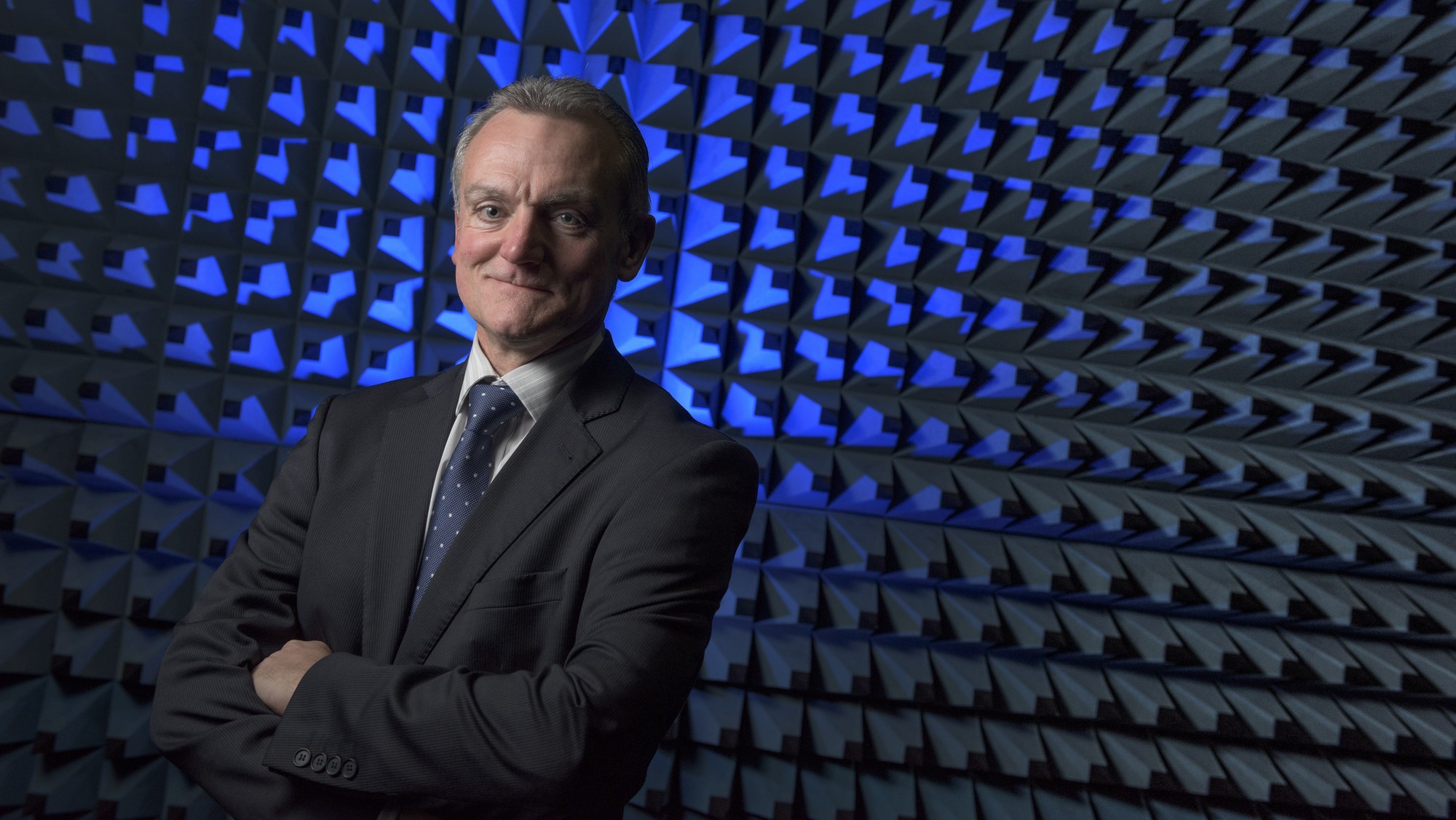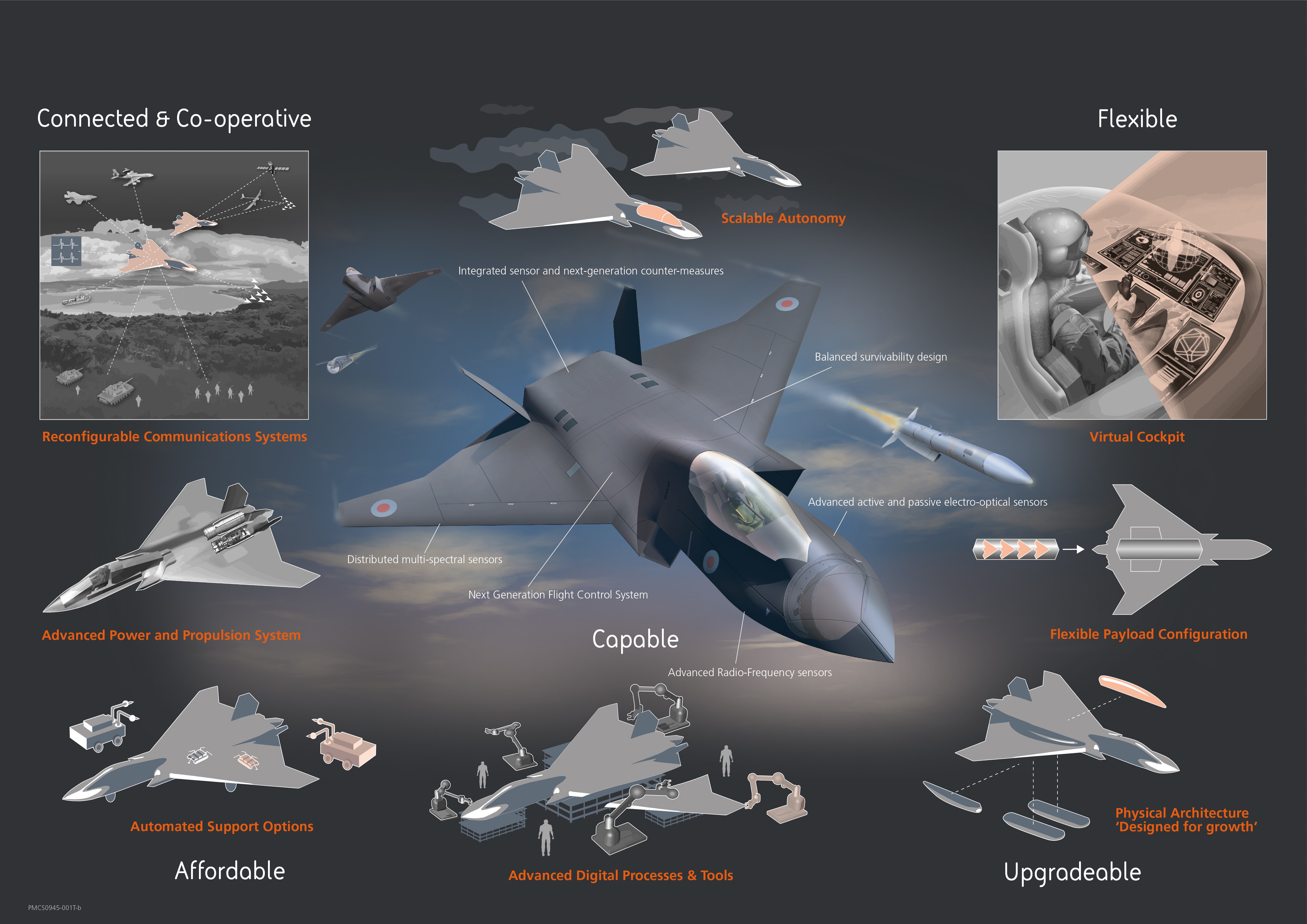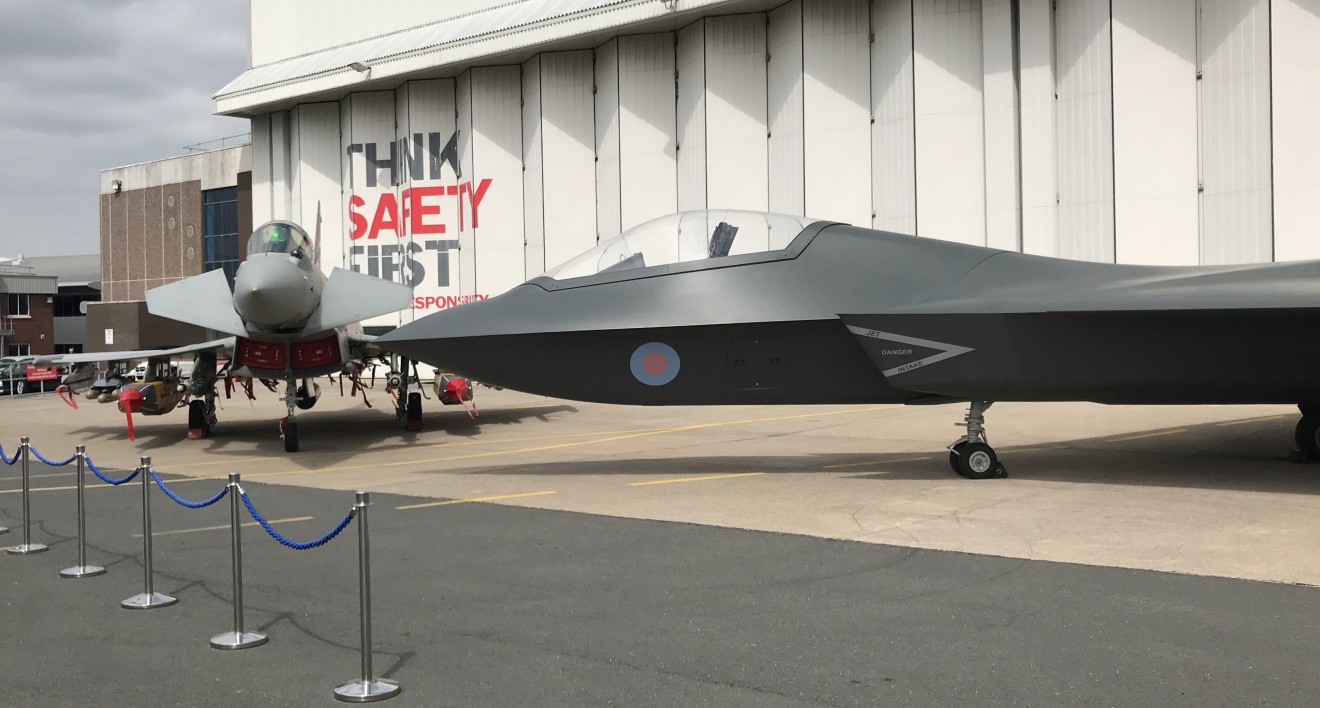How does Tempest fit into the future combat air picture?
The best place to start is with the UK’s Combat Air Strategy. Announced at Farnborough last year, it looks at the overall challenges we face and talks about how industry and government can work together, but differently. The other thing that happened that day was the launch of an overall agreement between industry and government that we called ‘Team Tempest’.
Team Tempest is BAE Systems, Rolls- Royce, Leonardo, MBDA and the Ministry of Defence jointly working together, funding a programme to deliver a very wide-ranging set of technology demonstrations. They cover technology areas specific to those companies but go beyond that and include some broader concept work as well.
The model unveiled at Farnborough was there to give a vision of what the fighter component of that overall system could be. The slight danger of creating a model is that people think that the only thing we’re looking at is the aeroplane, when in fact we are looking at a ‘system of systems’. That said, we believe any future airborne air defence environment will include a fighter component.
What are the main challenges Team Tempest face and what timescales are you working towards?
Air defence capability will need to be replenished in the UK and other European nations somewhere between the 2030s and 2060s. We are working at getting some- thing into service in the mid-30s. If you look back at the history and complexity of these programmes we’re talking about a system that’s more complex than the last generation, however, we’re aiming to do it in a timescale that’s faster than the last.

Michael Christie
Obviously, there are technological challenges, but there are also behavioural and team-working challenges. In addition, our vision is that this will be an international collaborative programme from the outset. Take all that together, a 2035 entry to service date, next generation capability, a system of systems and international partnership, it means we have got to go quickly and we’ve got to do things differently.
Last year was an example of doing things very differently. The Combat Air Strategy was published in the UK and an eight-year agreement between five parties was launched. Things are moving at a rate of knots. The next stage is to engage with international partners and we are already entering a deepening dialogue with Sweden.
Why the emphasis on collaboration now?
We firmly believe that any future programme is going to be collaborative and the best way to do that is to involve people at the earliest stage. In the early days on Eurofighter we had a national requirement, which became a European requirement. That created focus which is great, but also a challenge to balance national and wider programme requirements. However, collaboration is absolutely the right way forward.
We have an interesting challenge. We don’t have a stated national requirement and that gives us some freedom and flex. Obviously, we want to get to the point where there’s clarity on what we’re actually going to put into service but engaging with future international partners at this early stage allows them to influence and shape what is to come.
By late 2020 we will go from the concept to the assessment phase. We will then have to have a much clearer view about what the collaborative options are. The MOD will select their options by 2025.
In technology terms, what are your priorities?
Well, we are talking about multiple assets, rather than trying to do everything on one. That makes the individual assets potentially simpler. The trend to date has been for platforms to become increasingly complex as you try to do more with them. Now, we’re looking at the potential of distributed systems, wing men, but wing men of different kinds. A system that operates on a lot of different platforms, but one that will still have platform technologies.
But it will also need to be affordable. So, we will be looking at how we can manufacture it more efficiently, and how we can architect it better for upgrades.
At Farnborough, for instance, we showed a helmet as part of a software configurable cockpit — with virtually no equipment in the cockpit — it was an extreme version, but we believe it’s achievable.
In short, we’re looking at things that are affordable, upgradable and exportable to provide a level of features and options that are not cost prohibitive. There’s a level of business thinking in this as well as just pure military thinking — there has to be.
So we are looking at something with open mission system architectures and flexible, software configurable cockpits, but also with sophisticated platform and sensing technologies.
Come 2035 what might we expect to see roll out of the hangar doors?
It will probably still be an iconic fighter aircraft but with lots of related systems.
How does the future battlespace come into your thinking?
It’s a big part of the thinking. It’s why it has to be upgradable because there’s only so much you can predict about what the environment in 2035 is going to be like. We can deal with this uncertainty by having a system of systems rather than a single platform. And if you design in upgradability, you’ll be able to respond to whatever the change in threat is.
What are your thoughts on the future battlespace in terms of the different kinds of threats that are emerging?
The emergence of sensor technologies and defence counter-technologies means we’re going to operate in a different way. I have an image of a multi-tiered battlespace with a commander largely sitting at the back, then a slightly riskier tier and final an even more risky tier, with different assets used at each of those tiers.

The other real challenge we’ve got is that there’s this thing called the ‘grey space’ where it’s not either warfare or peace but rather a grey conflict and that will mean different thinking about the assets we need. The future battlespace will be very complex and we don’t want a one-size-fits- all solution.
How do you envisage being able to deal with a mass threat or swarm?
The quote I’ve heard from Chief of The Air Staff: “Do you need capability or mass?” and his answer is “Both, I want mass but I want high capability at the same time.”
The challenge for us is not to try and put all of the capability into something and then have it in mass because that would be too expensive. You can create the mass by using smaller, arguably less sophisticated aircraft. But the way they’re connected is still quite sophisticated.
How you fight somebody who’s coming at you with mass, takes you into different weapons technologies. In short, you’d have to have the right defensive technologies.
You are painting a picture of a mix of unmanned and manned assets.
I believe that the next generation is going to have a mix and with manned/unmanned teaming. One of the challenges is working out what the man does and what the machine does.
Autonomy is still going to be used heavily as a decision aid. AI will go through everything it can see and say, “That’s what I think you should do, what do you think?” Then the man can make the final call. Fundamentally it means you’ve got a man controlling, or a man plus a machine controlling a bunch of other machines.
And this can be done using existing assets. For example, Eurofighter could be given the capability to manage a bunch of UAVs. That technology is something we have already looked at and software development that looks at how you would manage a fleet of UAVs from a single Eurofighter has been carried out.
What role do you see Eurofighter playing in the future?
Many of the concepts and technologies will be developed on Eurofighter in advance. For example, with the advanced cockpit, you might not want to go to the full helmet-only option but you could go to a halfway house to mature the technology.
It would be very valuable for Eurofighter today to have more in the helmet and less in the head down display. The system architectures could be very valuable too and enable continued upgrades because Eurofighter is going to be in service for many decades.
A lot of what we’re looking at is back-transferable onto Eurofighter. There’s a double-positive here. Eurofighter can benefit from being part of this journey, and those future programmes can benefit from Eurofighter maturing the technology along the way.
I believe there’s a sort of roll-forward/roll- back capability. We’ll find opportunities to feed the work we are doing on Tempest into Eurofighter development. Not only will Typhoon remain at the forefront of technology, but it will also be the natural partner to work alongside a future fighter in the decades to follow.
What other technology areas being looked at?
A key area is autonomy, with decision aids and autonomous processing forming a massive aspect of what we’ll be doing. Clearly if the asset is going to be autonomous it’s vital but it’s equally important for the high workload of a pilot. We’ve done a lot of work for many years on autonomous aircraft and that will get fed through into the next manned generation, as well as the next unmanned generation.
Another key area is what I call ‘affordable stealth’. That’s trying to get to a level of stealth but doing it without a massive premium. It’s key to making something affordable and exportable.
Then there’s the mission system architecture. We want something that enables quick upgrades so that when you make a change to the aircraft it’s like loading an app on your smartphone. Trying to do that whilst retaining safety and clearance of an aircraft is a lot easier said than done, but we need flexibility and upgradability because we know things are going to change. You want to be able to change something without incurring a huge cost or time penalty.
With so many different assets operating together how important will connectivity be?
Secure connectivity or making sure that you can securely communicate between the various assets, is crucial. The next generation will be all about information, and information dominance will be key. Having multiple assets and strong situational awareness means information will be at the heart of everything.
The Team Tempest construct isn’t just about an airframe. There’s a sensor business and a weapons business in there. You’ve also got Rolls-Royce who will pro- vide propulsion but they’ll also play a role in power and thermal management across the whole system. There is a whole set of complex issues for each of the individual companies as well as that broader connectivity idea.
For me being a leader in the information generation is going to be about how you manage all that information properly. When you talk about multiple assets, both yours and the enemies, it’s all about situational awareness. That’s all about knowing where everything is, who’s a friend, who’s a foe.
That’s also today’s problem but it’s going to be much more complex in the next generation. Then you’re going to have to be able to decide what’s the best course of action to take in this three-dimensional game of chess.
One thing to stress through all this is that we’re thinking about how to make all this affordable. It could become a massive tech- fest and we could be here until 2050 trying to define the perfect solution. That’s not the right way to do this.
You’ve got all these kind of technology threads that you’re pulling together and some will be at different maturities, levels, but how do you decide where the priorities lie?
The answer gets ever more complex when you add other international partners because everybody’s priorities are slightly different. What we’re trying to do now is flush out, what do we need to do first?
We don’t need to do everything on day one but what we do need to do is to make sure that whatever we do on day one is capable of getting to day two, day three, and so on.
It’s about achieving what I call the ‘minimum viable product’, it can’t just be a shell that does nothing. We get to the ‘minimum viable product’ point and then spiral it. We’ve been talking about spiral development for decades but the system architecture will be key to making spiral development credible, possible and affordable — that last word is the hardest.
Spiral development is complex, you end up with mid-life upgrades. If we have mid-life upgrades it means we’ve failed because the idea is you’ll be able to constantly update.
How important do you think it is for Europe to develop its own capability and fund the development of these new technologies?
In the UK and across Europe, we feel the need to have freedom of action — it is referenced heavily in the strategy document. It’s something that Europe ought to be protecting. That expands to protecting its industrial capability because freedom of action is strongly linked to industrial capability. A nation won’t have full freedom of action if it doesn’t have a strong industry. There are a lot of reasons why European governments need to be looking at this. It’s clear there are emerging threats and capabilities being developed in other parts of world and we have to keep an eye on this military capability.
In broad terms Europe has got to look at its defence capability and be really careful that it doesn’t become completely reliant on offshore purchasing. It’s partly this that’s driving us to look at a much more joined up approach between industry and government.
There’s a line in the strategy documents that sums it up. It’s “our vision for the UK to remain at the leading edge of Combat Air system development to protect our people, project influence and promote our prosperity. To do this the Ministry of Defence and industry must build on success, rapidly change our approach and work together to achieve common goals.”
Six months in are the partnerships working as well as you’d hoped for?
Yes, there’s been a lot of good progress and everything that was committed to has been met. The Combat Air Acquisition team stood up within six weeks of Farnborough and the technology demonstrations were launched almost immediately.
Farnborough created internal momentum and was a very positive message. It also meant I got lots of phone calls from people in the UK supply chain, as well as from potential international partners.
It created a lot of energy and momentum and we have managed to keep the momentum going. We’ve made a lot of progress since then on some of the individual technology initiatives and the international engagement side of things.
